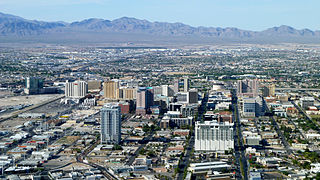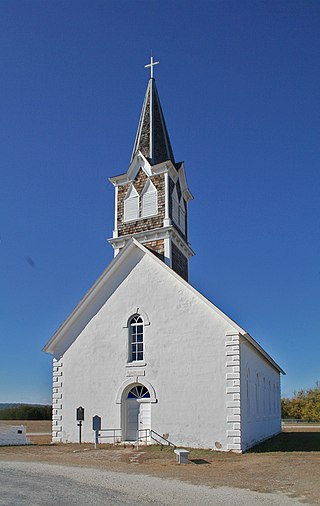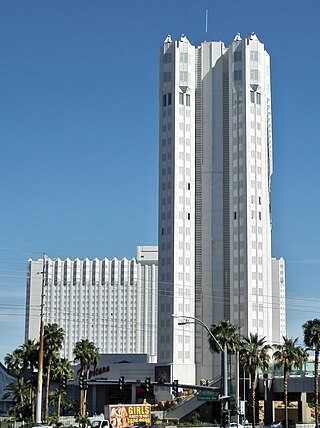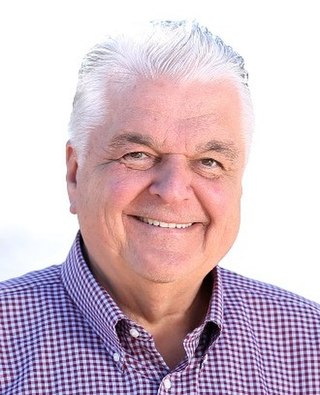Related Research Articles

Las Vegas, often known simply as Vegas, is the 25th-most populous city in the United States, the most populous city in the state of Nevada, and the county seat of Clark County. The Las Vegas Valley metropolitan area is the largest within the greater Mojave Desert, and 2nd-largest in the Southwestern United States. Las Vegas is an internationally renowned major resort city, known primarily for its gambling, shopping, fine dining, entertainment, and nightlife. The Las Vegas Valley as a whole serves as the leading financial, commercial, and cultural center for Nevada.

Cranfills Gap is a town located in Bosque County in central Texas, United States. It was founded by Norwegian Emigrants and to this day most residents can trace their lineage to those Norwegian Founders. The population was 281 at the 2010 census.

The Westgate Las Vegas Resort & Casino is a hotel, casino, and timeshare resort in Winchester, Nevada. Located near the northern end of the Las Vegas Strip, it is owned by Westgate Resorts. It opened in 1969 as the International Hotel, and was known for many years as the Las Vegas Hilton, then briefly as the LVH – Las Vegas Hotel and Casino. From 1981 to 1990, it was the largest hotel in the world.

The Las Vegas Valley is a major metropolitan area in the southern part of the U.S. state of Nevada, and the second largest in the Southwestern United States. The state's largest urban agglomeration, the Las Vegas Metropolitan Statistical Area is coextensive since 2003 with Clark County, Nevada. The Valley is largely defined by the Las Vegas Valley landform, a 600 sq mi (1,600 km2) basin area surrounded by mountains to the north, south, east and west of the metropolitan area. The Valley is home to the three largest incorporated cities in Nevada: Las Vegas, Henderson and North Las Vegas. Eleven unincorporated towns governed by the Clark County government are part of the Las Vegas Township and constitute the largest community in the state of Nevada.

The Tropicana Las Vegas is a casino hotel on the Las Vegas Strip in Paradise, Nevada. It is owned and operated by Bally's Corporation, on land leased from Gaming and Leisure Properties. It offers 1,467 rooms, a 50,000-square-foot (4,600 m2) gaming floor, and 72,000 sq ft (6,700 m2) of convention and exhibit space.

Luxor Las Vegas is a 30-story casino hotel situated on the southern end of the Las Vegas Strip in Paradise, Nevada. The hotel is owned by Vici Properties and operated by MGM Resorts International and has a 120,000-square-foot (11,000 m2) casino with over 2,000 slot machines and 87 table games.

The Las Vegas Convention Center is a convention center in Winchester, Nevada. It is owned and operated by the Las Vegas Convention and Visitors Authority.

The Welcome to Fabulous Las Vegas sign is a Las Vegas landmark funded in May 1959 and erected soon after by Western Neon. The sign was designed by Betty Willis at the request of Ted Rogich, a local salesman, who sold it to Clark County, Nevada.

Riviera was a hotel and casino on the Las Vegas Strip in Winchester, Nevada, which operated from April 1955 to May 2015. It was last owned by the Las Vegas Convention and Visitors Authority, which decided to demolish it to make way for the Las Vegas Global Business District.

Raley's Supermarkets is an independent, family-owned American grocery and retail technology company headquartered in West Sacramento, California. Raley's was founded in 1935 by Thomas P. Raley in Placerville, California.

The Southern Nevada Zoological-Botanical Park, informally known as the Las Vegas Zoo, was a 3-acre (1.2 ha), nonprofit zoo and botanical garden located in Las Vegas, Nevada that operated from 1981 to September 20, 2013. It was located northwest of the Las Vegas Strip, about 15 minutes away. It focused primarily on the education of desert life and habitat protection. Its mission statement was to "educate and entertain the public by displaying a variety of plants and animals". An admission fee was charged. The park included a small gem exhibit area and a small gift shop at the main exit. The gift shop and admission fees helped support the zoo.
Robert T. Beers is an American accountant (CPA) and member of the Republican Party. He was previously an elected member of the Nevada Assembly from 1998 to 2004, the Nevada Senate from 2005 to 2008, and the Las Vegas City Council from 2012 to 2017. He ran unsuccessfully for the Republican nomination for Governor of Nevada in 2006. In January 2014, he announced that he would run against Democratic Senator Harry Reid in the 2016 U.S. Senate election, but he withdrew from the race in June 2015. In 2018, he was defeated for Nevada State Treasurer by Zach Conine.

The Las Vegas Convention and Visitors Authority(LVCVA) is a government agency and the official destination marketing organization for Southern Nevada. It was founded by the Nevada Legislature in 1955. The LVCVA owns and operates the Las Vegas Convention Center (LVCC) and is responsible for the advertising campaigns for the Clark County, Nevada area. The LVCVA also owns the Las Vegas Convention Center Loop, the Las Vegas Monorail, and the Las Vegas News Bureau. The LVCVA previously operated the Cashman Center complex; however the City of Las Vegas took control at the end of 2017 and is evaluating possibilities for the facility's future.
R&R Partners is an American advertising, marketing, public relations, and public affairs firm based in Las Vegas, Nevada. They are known for creating the ad campaign "What Happens Here, Stays Here," for the Las Vegas Convention and Visitors Authority (LVCVA). R&R maintains domestic and international clients through its headquarters in Las Vegas, and eight locations in ; Mexico. In 2013, Adweek named R&R Partners the top marketing agency in the state of Nevada. It was also named one of the best places to work in marketing and media by Advertising Age.

Town Square is an open-air shopping, dining, office, and entertainment center in Enterprise, Nevada, United States. It occupies approximately 100 acres (40 ha), located one mile south of the Las Vegas Strip. It was developed by Centra Properties and Turnberry Associates. Construction began in 2005, with Marnell Corrao Associates as general contractor. Town Square opened on November 14, 2007. It has 1.5 million square feet (140,000 m2), including 350,000 sq ft (33,000 m2) of office space. In 2017, Town Square was sold to Teachers Insurance and Annuity Association of America and Fairbourne Properties, with the latter also handling management.
Nevada Policy, formerly the Nevada Policy Research Institute, is a private non-profit, free-market and limited-government policy research organization based in Las Vegas, Nevada. Nevada Policy seeks to promote private, rather than government, solutions to issues facing Nevada and the western region of the United States.

Stephen F. Sisolak is an American businessman and politician who served as the 30th governor of Nevada from 2019 to 2023. A member of the Democratic Party, he served on the Clark County Commission from 2009 to 2019 and on the Nevada Board of Regents from 1999 to 2008.

The 2022 Nevada gubernatorial election took place on November 8, 2022, to elect the governor of Nevada. Incumbent Democratic governor Steve Sisolak lost re-election to a second term, being defeated by Republican nominee, Clark County Sheriff, Joe Lombardo.

The 2022 United States House of Representatives elections in Nevada were held on November 8, 2022, to elect the four U.S. representatives from the state of Nevada, one from each of the state's four congressional districts. The elections coincided with the Nevada gubernatorial election, as well as other elections to the U.S. House of Representatives, elections to the U.S. Senate, and various state and local elections.

Tuscany Village is a golf course community located in Henderson, Nevada. It was originally proposed by developer Jim Rhodes in 1995, under the name Palm City. The project was proposed for the former site of the Stewart gravel pit. The surrounding area initially sparked concern about the location's suitability, due to various environmental issues at the time. The site was located near sewage ponds and a longtime manufacturer of chemicals which had contaminated the land. Ground water was also found to have high radioactive levels.
References
- 1 2 3 4 Evans, K.J. (February 7, 1999). "Steve Hannagan". Las Vegas Review-Journal. Retrieved October 10, 2022.
- ↑ Townsley, Michael (2020). Steve Hannagan: Price of the Press Agents and Titan of Modern Public Relations. Gatekeeper Press. ISBN 978-1-6629-0722-7 . Retrieved October 10, 2022.
- 1 2 3 4 5 6 Gragg, Larry D. (2019). Becoming America's Playground: Las Vegas in the 1950s. University of Oklahoma Press. ISBN 978-0-8061-6553-0 . Retrieved October 10, 2022.
- ↑ "High-Powered Publicity Firm To 'Sell' Clark County, Vegas" . Las Vegas Review-Journal. May 21, 1948. Retrieved October 11, 2022.
- ↑ "Hannegan, Staff Prepares Publicizing District" . Las Vegas Review-Journal. June 16, 1948. Retrieved October 11, 2022.
- ↑ "Chamber to Hear Hannegan Plans" . Las Vegas Review-Journal. July 18, 1948. Retrieved October 11, 2022.
- 1 2 3 Foster, Jonathan (2018). Stigma Cities: The Reputation and History of Birmingham, San Francisco, and Las Vegas. University of Oklahoma Press. ISBN 978-0-8061-6225-6 . Retrieved October 10, 2022.
- 1 2 Smith, John L. (May 20, 2021). "Book reminds us of those who promoted Vegas in sunshine and shadow". CDC Gaming Reports. Retrieved October 10, 2022.
- 1 2 Fabulous Las Vegas. Beautiful America Publishing Co. 2006. p. 75. ISBN 978-0-89802-815-7 . Retrieved October 10, 2022.
- 1 2 "Las Vegas News Bureau". Clark County, Nevada. December 1, 2009. Retrieved October 10, 2022.
- ↑ White, Ken (December 13, 2002). "Ghost of Vegas Past". Las Vegas Review-Journal. Archived from the original on March 9, 2005.
- ↑ Coughtry, Jamie (1987). "John F. Cahlan: Fifty Years in Journalism and Community Development". University of Nevada Oral History Program. p. 159. Retrieved October 10, 2022.
- 1 2 3 4 5 6 Cohen, Jonathan D.; Schwartz, David G. (2018). All In: The Spread of Gambling in Twentieth-Century United States. University of Nevada Press. pp. 81–92. ISBN 978-1-943859-61-0 . Retrieved October 11, 2022.
- ↑ Smith, John L. (April 19, 2006). "News Bureau's 'heart and soul' showed irresistible side of Las Vegas". Las Vegas Review-Journal. Archived from the original on April 21, 2006.
- 1 2 Leach, Robin (November 9, 2015). "Las Vegas News Bureau salutes Frank Sinatra with three photo exhibits". Las Vegas Sun. Archived from the original on July 8, 2018.
- 1 2 Schorr, Melissa (March 2, 1999). "Rat Pack pack rats". Las Vegas Sun. Retrieved October 10, 2022.
- ↑ Evans, K.J. (May 17, 1998). "Crooner no stranger to LV publicity stunts". Las Vegas Review-Journal. Archived from the original on June 12, 1998.
- 1 2 3 Crowley, Matthew (July 1, 1998). "Worth more than words: A photo taken 45 years ago changed the image of Las Vegas". Las Vegas Review-Journal. Archived from the original on November 4, 1999.
- ↑ Whaley, Sean (April 19, 2006). "His eye sold nation on Las Vegas" . Las Vegas Review-Journal. Retrieved October 11, 2022.
- ↑ Morrison, Jane Ann (May 7, 2012). "News Bureau showed sexy sells". Las Vegas Review-Journal. Retrieved October 11, 2022.
- ↑ "Question of the Day". Las Vegas Advisor. May 19, 2011. Retrieved October 11, 2022.
- ↑ Feldberg, Sarah (May 16, 2012). "Learning from and repeating history with the Miss Atomic Bomb photo recreation". Las Vegas Weekly. Retrieved October 11, 2022.
- ↑ "Name Is Changed" . Las Vegas Review-Journal. May 19, 1955. Retrieved October 9, 2022.
- ↑ Przybys, John (September 10, 2021). "Payne, news bureau manager who helped to market Las Vegas, dies". Las Vegas Review-Journal. Retrieved October 10, 2022.
- ↑ Cross, joe (February 18, 1982). "Selling a city bureau's task" . Las Vegas Review-Journal. Retrieved October 11, 2022.
- ↑ "LV News Bureau to shut down" . Las Vegas Review-Journal. May 30, 1992. Retrieved October 9, 2022.
- ↑ "News Bureau will be missed" . Las Vegas Review-Journal. June 5, 1992. Retrieved October 9, 2022.
- ↑ Retrieved October 9, 2022:
- "Executives vow to save Las Vegas News Bureau" . Las Vegas Review-Journal. June 3, 1992.
- "LV News Bureau to stay open" . Las Vegas Review-Journal. June 24, 1992.
- "Bureau gets good, bad news" . Las Vegas Review-Journal. June 24, 1992.
- "Officials disagree on LV News Bureau" . Las Vegas Review-Journal. July 15, 1992.
- ↑ "Borders will head LV News Bureau" . Las Vegas Review-Journal. August 21, 1992. Retrieved October 9, 2022.
- ↑ Deskin, Ruthe (January 24, 2002). "Borders is still real news". Las Vegas Sun. Retrieved October 11, 2022.
- ↑ "Borders reflects on trailblazing career". Las Vegas Sun. July 23, 2002. Retrieved October 11, 2022.
- ↑ Bond, Tiffanie (December 29, 2004). "Keepers of the history". View News. Archived from the original on February 23, 2005.
- ↑ White, Ken (December 31, 2004). "Looking at History". Las Vegas Review-Journal. Archived from the original on January 3, 2005.
- 1 2 O'Brien, Matt (July 26, 2007). "The way we were". Las Vegas CityLife. Archived from the original on June 5, 2009.
- ↑ "News Bureau opens its vaults" . Las Vegas CityLife. October 4, 2007. Retrieved October 9, 2022.
- ↑ Jones, Jay (March 15, 2009). "Snapshots of Sin City". Los Angeles Times. Retrieved October 11, 2022.
- ↑ "Las Vegas News Bureau photo exhibit to tour" . Sunrise View. March 31, 2009. Retrieved October 9, 2022.
- ↑ Horwath, Bryan (November 4, 2021). "This Las Vegan's job is to keep an eye on the future by preserving the past". Las Vegas Sun. Retrieved October 10, 2022.
- ↑ "History: The Las Vegas News Bureau shoots to thrill". Nevada Public Radio. January 1, 2012. Retrieved October 10, 2022.